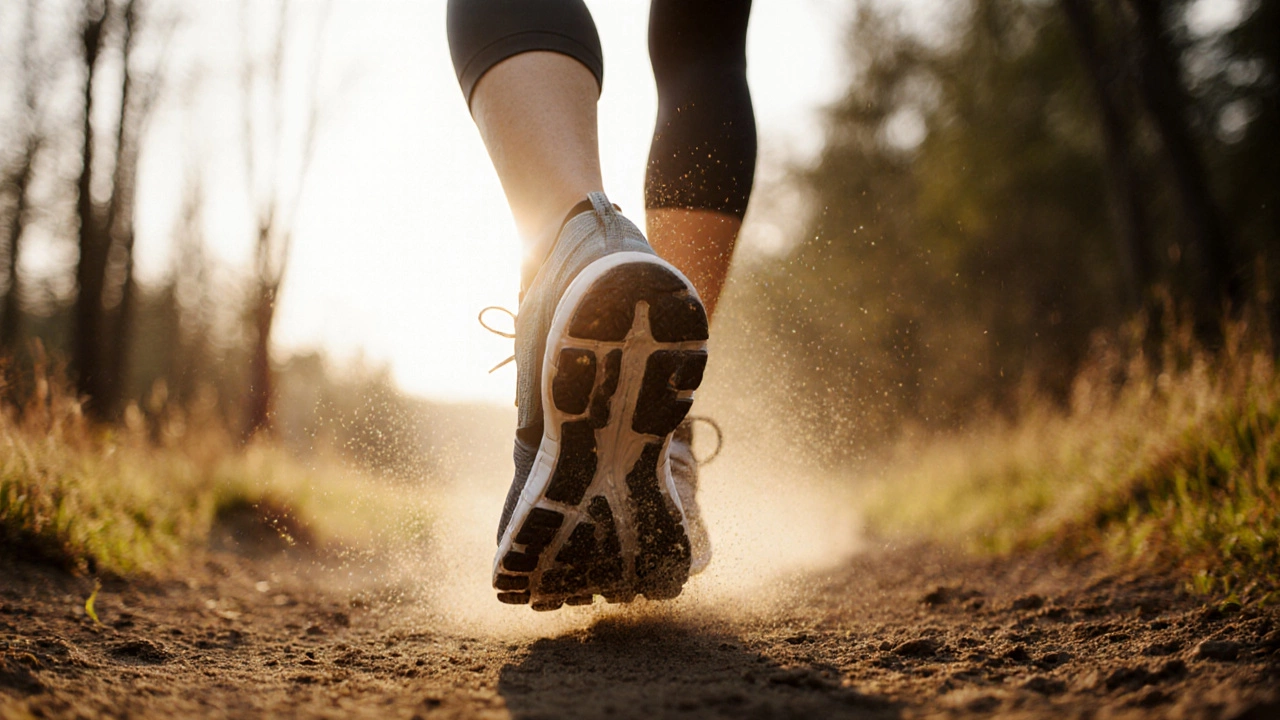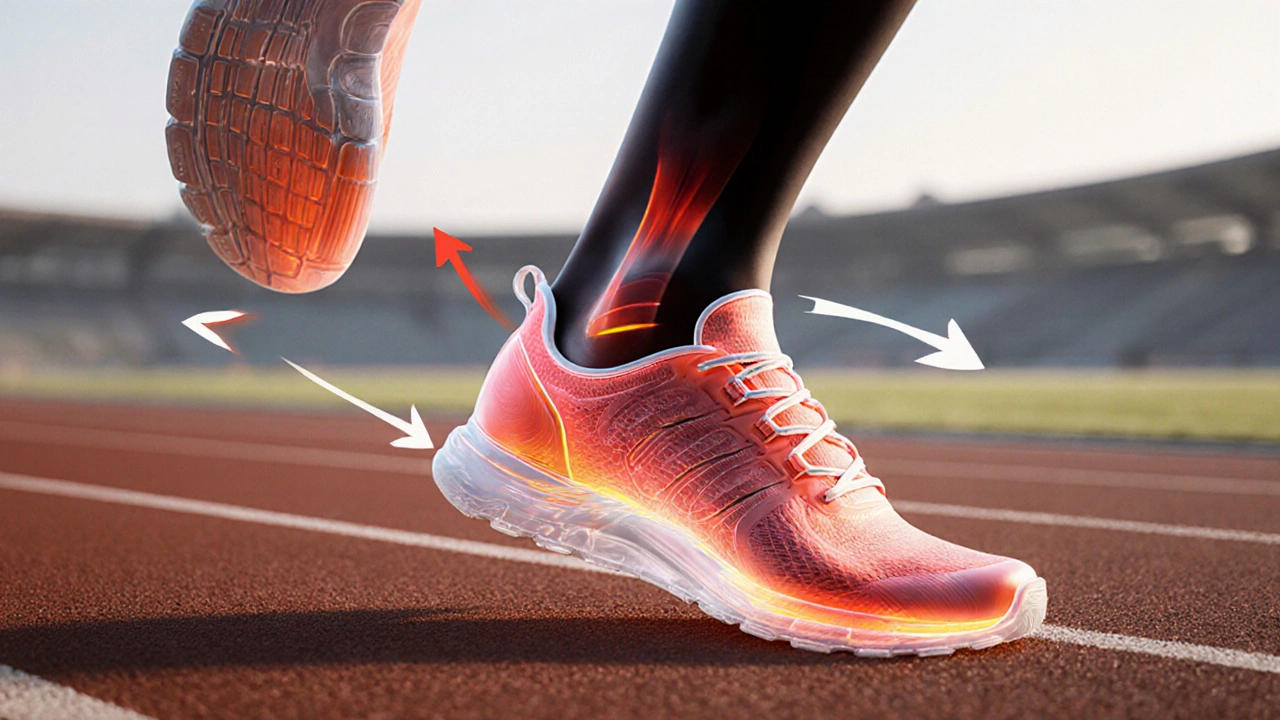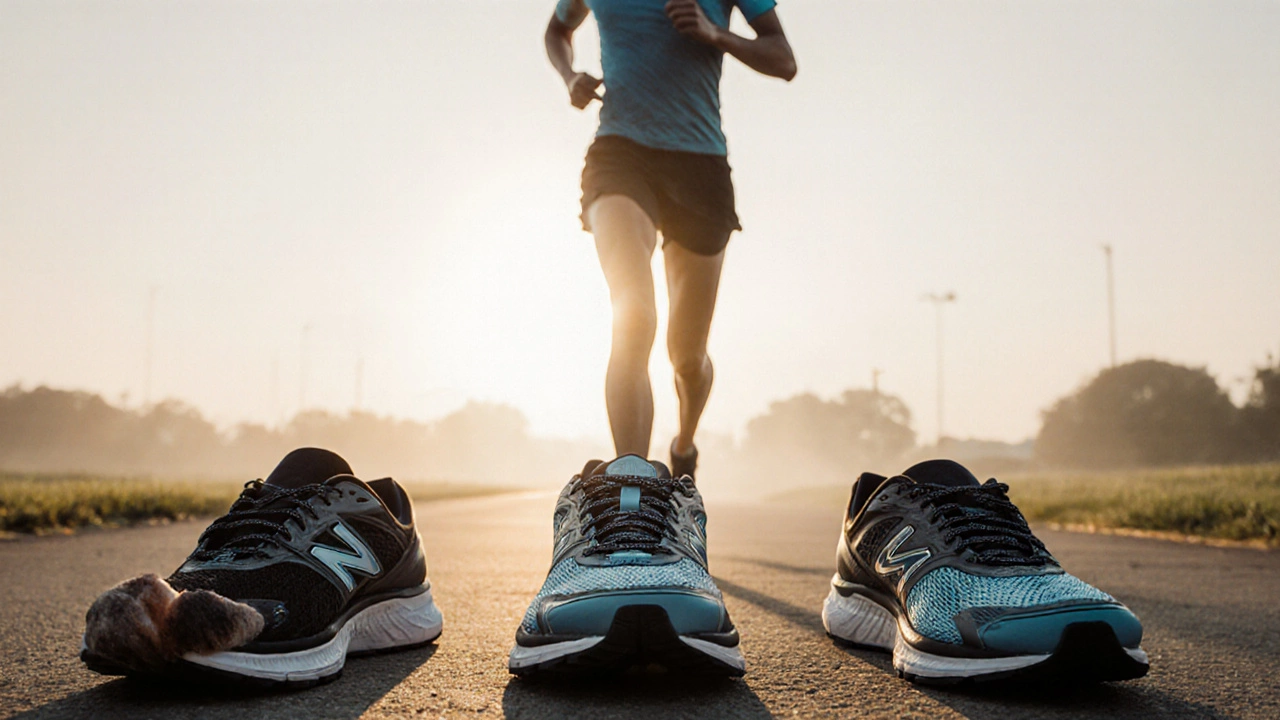Should You Buy Running Shoes a Size Bigger? The Real Answer
 Nov, 11 2025
Nov, 11 2025
Running Shoe Size Calculator
Ever bought a pair of running shoes that felt perfect in the store, only to have your toes smash into the front by mile three? You’re not alone. Many runners make the same mistake-choosing their usual shoe size without realizing running demands something different. The question isn’t just about comfort-it’s about injury prevention, performance, and long-term foot health. So, is it better to get running shoes a size bigger? The short answer: yes, most runners should go up half a size or even a full size. But here’s why, and how to get it right.
Why Your Feet Expand When You Run
Your feet aren’t static. When you run, your body pounds the ground with up to three times your body weight with every step. That impact pushes your foot forward inside the shoe. Your toes slam into the front. Your arch flattens. Your metatarsals spread. Your heel slips slightly. All of this happens in milliseconds, over and over, for miles.Studies from the American Podiatric Medical Association show that feet can expand by up to a full size during prolonged activity. That’s not a myth-it’s physics. If your shoe is snug at the toe box when you’re standing still, it’s going to feel like a prison by mile five. That’s when black toenails, bruised toes, and even stress fractures start showing up.
Think of it like this: you wouldn’t wear the same tight jeans for a sprint as you would for a walk. Your feet need room to move, swell, and absorb shock. Running shoes aren’t fashion accessories-they’re protective gear.
The Rule of Thumb: 1/2 to 1 Full Size Larger
Most running shoe brands design their shoes with a standard fit that assumes a sedentary foot shape. But your foot during a run is a different animal. The standard recommendation from running stores, podiatrists, and elite coaches is to go up half a size from your regular shoe size.For some runners-especially those with wide feet, high arches, or who run long distances-it’s even more. Marathoners and trail runners often need a full size bigger. Why? Because longer runs mean more swelling. Trail running means constant downhill pounding, which drives your foot forward harder than road running.
Here’s a simple test: when you’re trying on shoes, stand up, push your heel all the way back, and wiggle your toes. You should have about a thumb’s width of space between your longest toe and the end of the shoe. That’s roughly 3/8 to 1/2 inch. If your toe is touching, you’re too tight. If you can fit a full finger in there, you might be going too big.
What Happens If You Don’t Go Bigger
Wearing shoes that are too small doesn’t just feel uncomfortable-it’s dangerous. Here’s what can go wrong:- Black toenails: Blood pools under the nail from repeated impact. It’s painful, ugly, and can take months to grow out.
- Toe bruising and stress fractures: Constant pressure on the front of the foot can crack small bones in the metatarsals.
- Plantar fasciitis: Tight shoes force your foot into unnatural positions, straining the band that runs along the bottom of your foot.
- Blistering and calluses: Your toes rub against the front seam or toe box, especially if your foot slides forward.
- Reduced performance: Your foot can’t push off efficiently if it’s cramped. Power transfer drops.
One runner from Melbourne told me she ran 12 marathons in shoes that were too small. She lost three toenails, developed chronic heel pain, and didn’t realize her shoes were the cause until she switched to a half-size larger. Her times improved by 8 minutes per marathon after the change.

It’s Not Just About Length-Width Matters Too
Going up a size doesn’t mean you should ignore width. Many runners make the mistake of sizing up in length but still get a narrow shoe. That’s like putting your foot in a longer coffin. You still don’t have room to spread.Most running shoe brands offer wide versions (marked as 2E, 4E, or “Wide”). If your foot feels squeezed side-to-side-even if the length seems right-you need a wider model, not just a longer one. Brands like Brooks, New Balance, and Altra specialize in wider toe boxes that let your toes splay naturally.
Try this: stand on a piece of paper, trace your foot, and measure the widest part. Compare that to the width specs on the shoe’s product page. If your foot is wider than the shoe’s maximum width, skip it. No amount of sizing up in length will fix that.
How to Test Fit Properly
Don’t just try on shoes in the morning. Your feet swell throughout the day. The best time to shop is late afternoon or after a short run.Here’s how to test properly:
- Wear the same socks you run in-no thick wool, no barefoot.
- Stand up and press your big toe against the front of the shoe. There should be space-no pressure.
- Walk or jog in place. Your heel should stay locked in. No slipping.
- Flex your foot. The ball of your foot should sit right where the shoe bends.
- Check for pressure points. If your pinky toe feels pinched or your arch is compressed, it’s not right.
Some stores have pressure-mapping tech that shows where your foot is under stress. If you have access to one, use it. If not, trust your body. If it feels tight anywhere, it’s too tight.
What About Stability and Support?
Some runners worry that going up a size will make their shoes feel loose and unstable. That’s a common myth. Modern running shoes are designed with heel counters, midfoot support, and lacing systems that lock your foot in place even if the toe box is roomier.Look for shoes with a secure heel cup and a midfoot band (like Nike’s Flywire or Adidas’ Primeknit). These keep your foot from sliding around. The extra space in the toe box doesn’t mean your whole foot moves. It just means your toes have room to breathe.
One study from the University of Calgary tracked 120 runners over six months. Those who wore properly sized shoes (with toe room) had 40% fewer overuse injuries than those who wore snug-fitting shoes-even when both groups had the same arch support and cushioning.

Brand Differences Matter
Not all running shoes fit the same. A size 9 in Nike might be a size 8.5 in Asics and a full size 9.5 in Altra. That’s because each brand has its own last (the mold their shoes are built on).Here’s a quick guide to how major brands run:
| Brand | Typical Fit | Recommended Sizing Adjustment |
|---|---|---|
| Nike | Narrow, snug | +0.5 to +1 size |
| Adidas | Standard to slightly narrow | +0.5 size |
| Brooks | True to size, wide options | +0.5 size if wide foot |
| New Balance | True to size, excellent width options | +0.5 size |
| Altra | Foot-shaped, zero drop, wide toe box | True to size or -0.5 if used to narrow shoes |
| Asics | Roomy in toe, snug in heel | True to size |
Always check reviews for fit feedback. Look for comments like “runs small” or “toe box is tight.” Don’t assume your usual size works across brands.
What About Kids and Teens?
Growing feet need extra space-but not too much. Kids and teens should have about 1/4 inch of space at the toe. That’s enough for growth without risking instability. Going up a full size is usually too much and can cause tripping or poor form.Replace their shoes every 6-8 months if they’re active. Don’t wait for visible wear. Their feet grow fast, and tight shoes can affect development.
Final Tip: Don’t Guess-Measure
Your shoe size isn’t set in stone. Feet change with age, weight, pregnancy, injury, and even climate. A size 9 at 25 might be a 9.5 at 40. Measure your feet every year or two.Use a Brannock device if you can-it’s the gold standard. If not, trace your foot on paper, measure from heel to longest toe, and compare it to the brand’s size chart. Don’t rely on what you wore five years ago.
Running is one of the most accessible sports, but it’s also one of the most punishing on your body. Your shoes are your first line of defense. If you’re not giving your feet the space they need, you’re asking for trouble.
Go up half a size. Try a wider model if needed. Test them after a short jog. Listen to your toes. Your body will thank you when you’re still running at 60, with all your toenails intact.
Should I always buy running shoes a size bigger?
Most runners benefit from going up half a size, but not everyone needs a full size bigger. It depends on your foot shape, running distance, and shoe brand. The key is having about a thumb’s width of space between your longest toe and the end of the shoe when standing. If your toes are cramped, go bigger. If your heel slips, you might need a different model, not just a larger size.
Can wearing bigger shoes cause blisters?
Only if the shoe is too big in the heel or midfoot. A slightly larger toe box won’t cause blisters-it prevents them. But if your heel slips or your foot slides forward, that’s when friction happens. Make sure the shoe fits snugly around your heel and arch. Use moisture-wicking socks and consider lacing techniques like the heel-lock to keep your foot locked in place.
Do professional runners wear bigger shoes?
Yes. Elite runners often wear shoes half a size or more larger than their casual shoes. They know their feet swell during long runs and races. Many use custom insoles or orthotics to maintain stability, but they still leave room for toe splay. It’s not about comfort-it’s about performance and injury prevention.
What if my shoes feel loose after going up a size?
If the shoe feels loose overall, you might have chosen the wrong width or model. Try a different brand or style with a better heel lock. Many shoes have adjustable lacing systems (like Nike’s Flywire or Brooks’ GuideRails) that help secure the foot. Tighten the laces around the midfoot and use a heel-lock lacing technique to prevent slippage. Don’t just rely on size-fit is about the whole shoe.
Is it okay to wear running shoes for walking if they’re sized bigger?
Absolutely. In fact, many people prefer running shoes for walking because they offer better cushioning and support than typical walking shoes. The extra toe room is even more beneficial for walking, especially on long distances. Just make sure the shoe isn’t too heavy or overly cushioned for your walking pace-lightweight models like the Hoka Bondi or Saucony Ride work well for both.